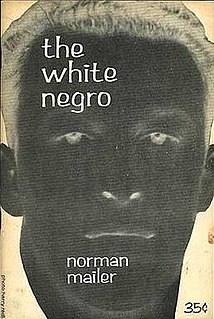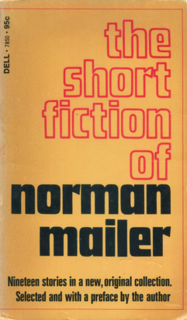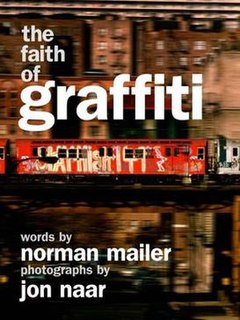Related Research Articles
Orgasm is the sudden discharge of accumulated sexual excitement during the sexual response cycle, resulting in rhythmic muscular contractions in the pelvic region characterized by sexual pleasure. Experienced by males and females, orgasms are controlled by the involuntary or autonomic nervous system. They are usually associated with involuntary actions, including muscular spasms in multiple areas of the body, a general euphoric sensation and, frequently, body movements and vocalizations. The period after orgasm is typically a relaxing experience, attributed to the release of the neurohormones oxytocin and prolactin as well as endorphins.

Norman Kingsley Mailer was an American novelist, journalist, essayist, playwright, activist, film-maker and actor. In a career spanning over six decades, Mailer had 11 best-selling books, at least one in each of the seven decades after World War II—more than any other post-war American writer.

The Naked and the Dead is a novel by Norman Mailer. Published by Rinehart & Company in 1948, when he was 25, it was his debut novel. It depicts the experiences of a platoon during World War II, based partially on Mailer's experiences as a cook with the 112th Cavalry Regiment during the Philippines Campaign in World War II. The book quickly became a bestseller, paving the way for other Mailer's works such as The Deer Park, Advertisements for Myself, and The Time of Our Time. He believed The Naked and the Dead to be his most renowned work. It was the first popular novel about the war and is considered one of the greatest English-language novels. It was later adapted into a film in 1958.

The Armies of the Night: History as a Novel/The Novel as History is a nonfiction novel recounting the October 1967 March on the Pentagon written by Norman Mailer and published by New American Library in 1968. It won the Pulitzer Prize for General Non-fiction and the National Book Award in category Arts and Letters. Mailer's unique rendition of the non-fiction novel was perhaps his most successful example of new journalism, and received the most critical attention. In Cold Blood (1965) by Truman Capote and Hell's Angels (1966) by Hunter S. Thompson had already been published, and three months later Tom Wolfe would contribute The Electric Kool-Aid Acid Test (1968).

An American Dream is a 1965 novel by American author Norman Mailer. It was published by Dial Press. Mailer wrote it in serialized form for Esquire, consciously attempting to resurrect the methodology used by Charles Dickens and other earlier novelists, with Mailer writing each chapter against monthly deadlines. The book is written in a poetic style heavy with metaphor that creates unique and hypnotising narrative and dialogue. The novel's action takes place over 32 hours in the life of its protagonist Stephen Rojack. Rojack is a decorated war-hero, former congressman, talk-show host, and university professor. He is depicted as the metaphorical embodiment of the American Dream.

The White Negro: Superficial Reflections on the Hipster, a 9,000-word essay by Norman Mailer, connects the "psychic havoc" wrought by the Holocaust and atomic bomb to the aftermath of slavery in America in the figuration of the Hipster, or the "white negro". The essay is a call to abandon Eisenhower liberalism and a numbing culture of conformity and psychoanalysis in favour of the rebellious, personal violence and emancipating sexuality that Mailer associates with marginalized black culture. The White Negro was first published in the 1957 special issue of Dissent, before being published separately by City Lights. Mailer's essay was controversial upon its release, winning praise, for example, from Eldridge Cleaver and equal criticism from James Baldwin. The thought-provoking work remains his most famous and most reprinted essay and it established Mailer's reputation as a "philosopher of hip".

J. Michael Lennon is an American academic and writer who is the Emeritus Professor of English at Wilkes University and the late Norman Mailer’s archivist and authorized biographer. He published Mailer's official biography Norman Mailer: A Double Life in 2013. He edited Mailer's selected letters in 2014 and the Library of America's two-volume set Norman Mailer: The Sixties in 2018.
Adele Carolyn Morales was an American painter and memoirist.

Why Are We In Vietnam? (WWVN) is a 1967 novel by the American author Norman Mailer. It focuses on a hunting trip to the Brooks Range in Alaska where a young man is brought by his father, a wealthy businessman who works for a company that makes cigarette filters and is obsessed with killing a grizzly bear. As the novel progresses, the protagonist is increasingly disillusioned that his father resorts to hunting tactics that seem dishonest and weak, including the use of a helicopter and taking credit for killing a bear. At the end of the novel, the protagonist tells the reader that he is soon going to serve in the Vietnam War as a soldier.

Lucas Johnson is a fictional character from the BBC soap opera EastEnders, played by Don Gilet. He made his first on-screen appearance on 3 April 2008. Lucas is introduced as a reformed drug addict and criminal-turned-preacher who appears as the estranged father of established character Chelsea Fox. He also has a young son, Jordan, and later goes on to marry Chelsea's mother Denise - whom he had previously been in a relationship with prior to their reunion.

The Deer Park is a Hollywood novel written by Norman Mailer and published in 1955 by G.P. Putnam's Sons after it was rejected by Mailer's publisher, Rinehart & Company, for obscenity. Despite having already typeset the book, Rinehart claimed that the manuscript's obscenity voided its contract with Mailer. Mailer retained his cousin, the attorney Charles Rembar, who became a noted defense attorney for publishers involved in censorship trials.

Advertisements for Myself is an omnibus collection of fiction, essays, verse, and fragments by Norman Mailer, with autobiographical commentaries that he calls "advertisements." Advertisements was published by G.P. Putnam's Sons in 1959 after Mailer secured his reputation with The Naked and the Dead, then endured setbacks with the less-enthusiastic reception of Barbary Shore (1951) and The Deer Park (1955). Advertisements, though chaotic, unapologetically defiant, and often funny, marks the beginning of Mailer's mature style.

The Time of Our Time is an anthology of Norman Mailer’s various literary works, published by Modern Library in 1998. The work was designed to commemorate both the fiftieth anniversary of The Naked and the Dead (1948), and Mailer’s seventy-fifth birthday. Norman Mailer edited the anthology himself, choosing to organize the content not by the chronology in which the pieces are written, but the chronology of the events that the works describe; some of the excerpts are written in the midst of the action, while others may come upon forty years of reflection. Selected texts that deal with the ancient world, however, appear out of sequence at the end of the volume. Excerpts from Mailer’s most notable works, including The Naked and the Dead, Advertisements for Myself (1959), "Superman Comes to the Supermarket" (1960), The Armies of the Night (1968), Miami and the Siege of Chicago (1968), Of a Fire on the Moon (1970), and The Executioner's Song (1979), as well as several works in their entirety, including "The White Negro: Superficial Reflections on the Hipster" (1957), "The Time of Her Time" (1959), and various transcribed and annotated interviews with the likes of William F. Buckley, Gore Vidal, Kate Millett, and John Ehrlichman.

"Superman Comes to the Supermarket" is an essay by American novelist and journalist Norman Mailer about the 1960 Democratic convention. Originally published in Esquire as "Superman Comes to the Supermart", this essay was Mailer's initial foray into political journalism. It characterizes John F. Kennedy as a potential "existential hero" who could revitalize the US after eight years under Dwight D. Eisenhower to rediscover its lost imagination. "Superman" further develops and emphasizes Mailer's concern with the importance of the individual's will and creativity that must challenge conformity and obedience in American life to fully realize a genuine life. With "Superman", Mailer extends New Journalism by making himself take an active role in the narrative which would influence his subsequent journalistic style and lead to his Pulitzer Prize for The Armies of the Night in 1968.

The Short Fiction of Norman Mailer is a 1967 anthology of short stories by Norman Mailer. It is grouped into eight thematic sections and contains nineteen stories, many appearing in one of Mailer's miscellanies; thirteen were published in periodicals or other anthologies before appearing in this collection. The collection was reprinted in hardcover in 1980 and some of the stories were reprinted in other volumes.

"The Man Who Studied Yoga", a novella by Norman Mailer written in 1952, was first published in the 1956 collection New Short Novels 2 then later in Mailer's 1959 miscellany Advertisements for Myself (AFM). It is a tale of a "writer manqué", or a writer who fails to write, reflecting some of Mailer's own anxiety in the 1950s as he tries to reinvent himself.
Beyond the Law is a 1968 independent film written by and starring Norman Mailer.

This Norman Mailer bibliography lists major books by and about Mailer, an American novelist, new journalist, essayist, public intellectual, filmmaker, and biographer. Over a fifty-nine-year period, Mailer won two Pulitzer Prizes and had eleven books spend a total of 160 weeks on the New York Times bestseller list. Mailer's output included forty-plus books and six decades of bestsellers on a wide range of topics, from World War II to Marilyn Monroe. His biographer J. Michael Lennon calls him the chronicler of the American Century, and a talent whose career has "been at once so brilliant, varied, controversial, improvisational, public, productive, lengthy and misunderstood".

Susan Mailer is an American psychoanalyst, writer, and academic who has lived in Chile since the 1980s. Mailer is the first born child of American writer Norman Mailer and his first wife Beatrice Silverman. She is the author of the 2019 memoir In Another Place: With and Without My Father Norman Mailer that chronicles her relationship with her famous father.

The Faith of Graffiti is a 1974 essay by American novelist and journalist Norman Mailer about New York City's graffiti artists. Mailer's essay appeared in a shorter form in Esquire and as a book with 81 photographs by Jon Naar and design by Mervyn Kurlansky. Through interviews, exploration, and analyses, the essay explored the political and artistic implications of graffiti. The essay was controversial at the time of publication because it attempts to validate graffiti as an art form by linking it with great artists of the past. Mailer, too, was criticized for using the essay as a platform for own political grievances. Faith grows out of Mailer's existential philosophy of the hip, in which a Hipster is guided by his instincts regardless of consequences or perception, and upholds graffiti as a subversive and healthy check on the status quo. Like several of his other non-fiction narratives, Mailer continues his use of new journalism: he adopts a persona, the A-I or "Aesthetic Investigator", to provide both an objective distance from the topic and to engender the text with the creative and critical eye of the novelist.
References
Cited
- 1 2 3 Mailer 1998, p. 318.
- ↑ Lennon 2014, p. 234.
- ↑ Lennon 2014, pp. 247, 250.
- ↑ Lennon 2014, p. 284.
- ↑ Lennon 2013, p. 277.
- ↑ Lennon & Lennon 2018, p. 42.
- 1 2 Mailer 1989.
- 1 2 3 Shapiro 1998.
- 1 2 Lennon & Lennon 2018, p. 134.
- ↑ Lennon 2013, p. 135.
- ↑ Peppard 2016, p. 312.
- ↑ Mailer 1998, p. 324.
- ↑ Mailer 1998, p. 329.
- ↑ Mailer 1998, p. 340.
- ↑ Mailer 1998, p. 342.
- ↑ Poirier 1972, pp. 68-69, 71.
- ↑ Mailer 1992, p. 438.
- ↑ Poirier 1972, p. 69.
- ↑ Gordon 1980, p. 113.
- ↑ Dearborn 1999, p. 135.
- ↑ Gordon 1980, p. 114.
- 1 2 Gordon 1980, p. 115.
- 1 2 3 4 5 Lucas 2013.
- 1 2 Trilling 1972, p. 60.
- ↑ Mailer 1967, p. 254.
- 1 2 Heyne 2000, p. 350.
- ↑ Gordon 1980, p. 117.
- ↑ Dearborn 1999, p. 136.
- ↑ Raines 1977, pp. 73-74.
- ↑ Delia 2000.
- ↑ Hills 1974, pp. 251–77.
- ↑ Lennon & Lennon 2018, p. 72.
Bibliography
- Dearborn, Mary V. (1999). Mailer: A Biography . Boston: Houghton Mifflin. ISBN 0395736552.
- Delia, Francis (Director, Writer) (2000). The Time of Her Time (Motion Picture). Turkey. Retrieved 3 May 2017.
- Gordon, Andrew (1980). An American Dreamer: A Psychoanalytic Study of the Fiction of Norman Mailer. Madison: Fairleigh Dickinson University Press. ISBN 0838621589.
- Heyne, Eric (2000). "Norman Mailer". In Gelfant, Blanche (ed.). The Columbia Companion to the Twentieth-Century American Short Story . Columbia University Press. ISBN 0231110987 . Retrieved May 3, 2017.
- Hills, Rust (1974). Writer's Choice: Each of Twenty American Authors Introduces His Own Best Story . D. McKay Co. pp. 251–77. Retrieved 25 July 2017.
- Lennon, J. Michael (2013). Norman Mailer: A Double Life. New York: Simon and Schuster. OCLC 873006264.
- — (2014). The Selected Letters of Norman Mailer. New York: Random House. ISBN 0812986091.
- —; Lennon, Donna Pedro (2018). Lucas, Gerald R. (ed.). Norman Mailer: Works and Days (Revised, Expanded ed.). Norman Mailer Society. ISBN 978-1-7326519-0-6 . Retrieved 2018-10-13.
- Lucas, Gerald R. (January 25, 2013). "The Minuet of Macho". GRLucas.net. Retrieved 2020-02-24.
- Mailer, Norman (1992) [1959]. Advertisements for Myself. Cambridge: Harvard UP. ISBN 0674005902. OCLC 771096402.
- — (1989). "Norman Mailer on Integrity". Academy of Achievement: A Museum of Living History. Retrieved 2011-06-20.
- — (1967). The Short Fiction of Norman Mailer. New York, N.Y.: Dell. ISBN 978-0523480091.
- — (1998). The Time of Our Time . Random House. ISBN 0375500979.
- Peppard, Victor (2016). "The Curious Story of Norman Mailer's Engagement With Short Fiction". The Mailer Review. 10 (1): 310–317.
- Poirier, Richard (1972). Norman Mailer . Modern Masters. New York: Viking Press. pp. 68–69, 71. ISBN 000632617X. OCLC 473033417.
- Raines, Helon Howell (Spring 1977). "Norman Mailer's Sergius O'Shaugnessy, Villain and Victim". Frontiers: A Journal of Women Studies. 2 (1): 71–75. JSTOR 3346110.
- Shapiro, James (May 10, 1998). "Advertisements for Himself,". New York Times. Web. Retrieved 2013-12-11.
- Stubin, Enid (2016). "'Don't Go Away Feeling Unequal': 'The Time of Her Time' and Mailer's Conciliatory Impulse". The Mailer Review. 10 (1): 302–309. Retrieved 2019-11-04.
- Trilling, Diana (1972). "The Radical Moralism of Norman Mailer". In Braudy, Leo (ed.). Norman Mailer: A Collection of Critical Essays. Prentice Hall. pp. 60. ISBN 0135455332.